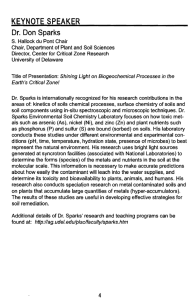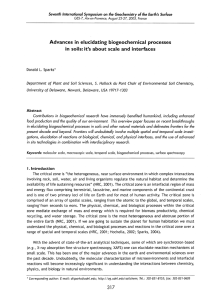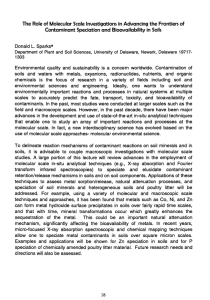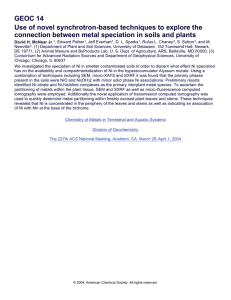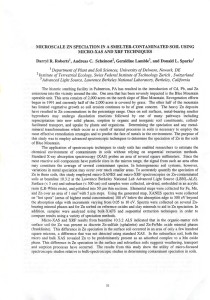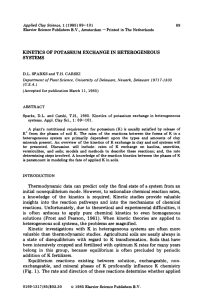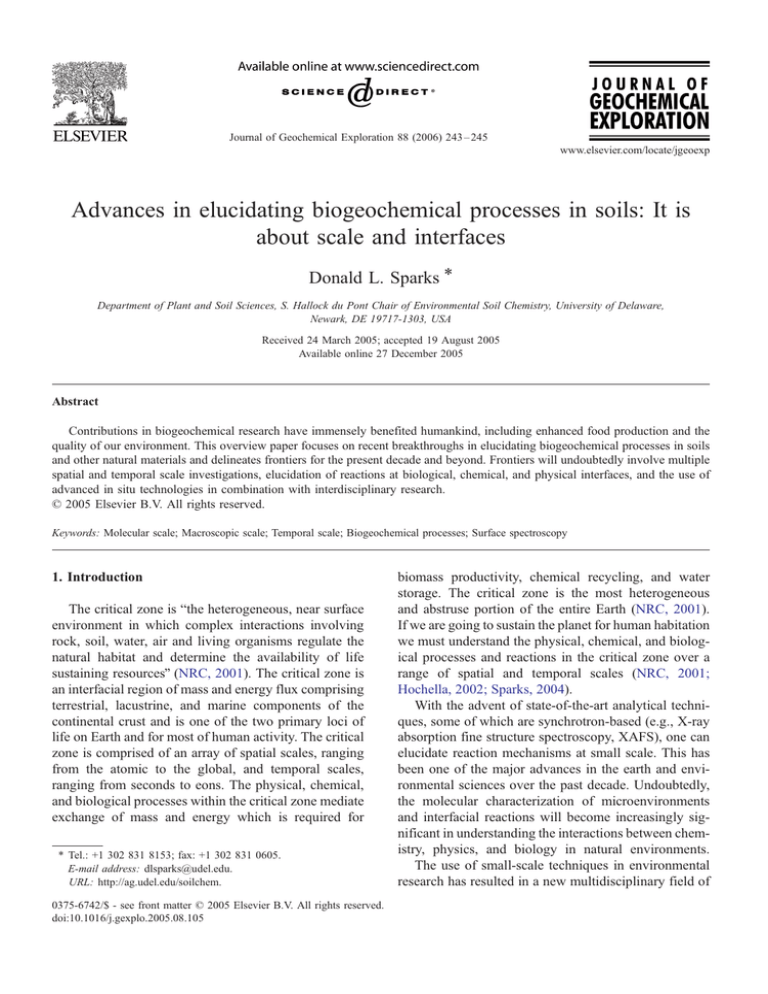
Journal of Geochemical Exploration 88 (2006) 243 – 245
www.elsevier.com/locate/jgeoexp
Advances in elucidating biogeochemical processes in soils: It is
about scale and interfaces
Donald L. Sparks *
Department of Plant and Soil Sciences, S. Hallock du Pont Chair of Environmental Soil Chemistry, University of Delaware,
Newark, DE 19717-1303, USA
Received 24 March 2005; accepted 19 August 2005
Available online 27 December 2005
Abstract
Contributions in biogeochemical research have immensely benefited humankind, including enhanced food production and the
quality of our environment. This overview paper focuses on recent breakthroughs in elucidating biogeochemical processes in soils
and other natural materials and delineates frontiers for the present decade and beyond. Frontiers will undoubtedly involve multiple
spatial and temporal scale investigations, elucidation of reactions at biological, chemical, and physical interfaces, and the use of
advanced in situ technologies in combination with interdisciplinary research.
D 2005 Elsevier B.V. All rights reserved.
Keywords: Molecular scale; Macroscopic scale; Temporal scale; Biogeochemical processes; Surface spectroscopy
1. Introduction
The critical zone is bthe heterogeneous, near surface
environment in which complex interactions involving
rock, soil, water, air and living organisms regulate the
natural habitat and determine the availability of life
sustaining resourcesQ (NRC, 2001). The critical zone is
an interfacial region of mass and energy flux comprising
terrestrial, lacustrine, and marine components of the
continental crust and is one of the two primary loci of
life on Earth and for most of human activity. The critical
zone is comprised of an array of spatial scales, ranging
from the atomic to the global, and temporal scales,
ranging from seconds to eons. The physical, chemical,
and biological processes within the critical zone mediate
exchange of mass and energy which is required for
* Tel.: +1 302 831 8153; fax: +1 302 831 0605.
E-mail address: dlsparks@udel.edu.
URL: http://ag.udel.edu/soilchem.
0375-6742/$ - see front matter D 2005 Elsevier B.V. All rights reserved.
doi:10.1016/j.gexplo.2005.08.105
biomass productivity, chemical recycling, and water
storage. The critical zone is the most heterogeneous
and abstruse portion of the entire Earth (NRC, 2001).
If we are going to sustain the planet for human habitation
we must understand the physical, chemical, and biological processes and reactions in the critical zone over a
range of spatial and temporal scales (NRC, 2001;
Hochella, 2002; Sparks, 2004).
With the advent of state-of-the-art analytical techniques, some of which are synchrotron-based (e.g., X-ray
absorption fine structure spectroscopy, XAFS), one can
elucidate reaction mechanisms at small scale. This has
been one of the major advances in the earth and environmental sciences over the past decade. Undoubtedly,
the molecular characterization of microenvironments
and interfacial reactions will become increasingly significant in understanding the interactions between chemistry, physics, and biology in natural environments.
The use of small-scale techniques in environmental
research has resulted in a new multidisciplinary field of
244
D.L. Sparks / Journal of Geochemical Exploration 88 (2006) 243–245
study that geoscientists are actively involved in—molecular environmental science. Molecular environmental science can be defined as the study of the chemical
and physical forms and distribution of contaminants in
soils, sediments, waste materials, natural waters, and
the atmosphere at the molecular level (Sparks, 2002,
2004). There are a number of areas in the geosciences
where the application of molecular environmental science is resulting in major frontiers. These include:
speciation of contaminants, which is essential for understanding release mechanisms, spatial resolution,
chemical transformations, toxicity, bioavailability, and
ultimate impacts on human health; mechanisms of microbial transformations; development of predictive
models; effective remediation and waste management
strategies; and risk assessment. Some of these frontier
areas will be discussed in the paper.
2. Results and analysis
Over the past 15 years, major advances have occurred in elucidating sorption mechanisms at the mineral/water interface. From these studies one can
conclude that sorption of alkali and alkaline earth elements primarily occurs via outer-sphere complexes
while for most other cations and anions, such as most
heavy metals and oxyanions, inner-sphere sorption
complexes result. Sorption of metals such as Co, Cr,
Mn, Ni, and Zn on mineral components and soils can
result in the formation of metal hydroxide precipitate
phases (Scheidegger et al., 1997). The formation of
these phases could be an important mechanism for
sequestering metals in soil and water environments
such that they are less mobile and bioavailable.
In the remaining section of this paper, I will focus
on the use of advanced micro-focussed synchrotronbased techniques to speciate metals in contaminated
soils. Other frontier topics that will be covered in the
oral presentation will include mineral/ microbe and
plant/soil interfacial reactions. Standard XAS techniques probe an area of several square mm. However,
the most reactive sites in soils have particle sizes in
the micrometer range and metal speciation may vary
over regions of a few 100 Am2. Therefore, the derived
structural information may be only an average of
several contaminant species. With the advent of third
generation synchrotron radiation facilities, which afford enhanced spatial resolution (b5 Am) and sensitivity, one can speciate metals in soils using microXAS and determine elemental distributions and asso-
Fig. 1. (a) A-SXRF tricolor maps for the treated soil samples. The numbers indicate the spots where A-EXAFS spectra were collected. Red is
indicative of the distribution of iron, green of copper and blue of zinc. (b) A-EXAFS spectra from selected spots on thin sections from treated soil.
The solid line indicates the raw k 3v(k) data and the dotted line indicates the best fits obtained with a linear fitting approach. From Nachtegaal et al.
(2005). (For interpretation of the references to colour in this figure legend, the reader is referred to the web version of this article).
D.L. Sparks / Journal of Geochemical Exploration 88 (2006) 243–245
ciations using micro-X-ray fluorescence (micro-XRF)
spectroscopy. An example of the use of these techniques
is shown in Fig. 1 from the research of Nachtegaal et al.
(2005). They investigated the speciation, distribution,
and association of Zn and its relation to mobility and
bioavailability of Zn in a non-remediated and a remediated (treated) smelter contaminated soil from Belgium. Overall, the researchers found that there were
no significant differences in Zn speciation between
samples of the two soils. About 30 to 50% of Zn was
in smelter related minerals (willemite, hemimorphite or
gahnite), while 50 to 70% of Zn was incorporated into
newly formed Zn precipitates (mixed Zn–Al layered
double hydroxides (LDH) in the non-remediated and
Zn-phyllosilicates in the remediated soil). Macroscopic
desorption and biosensor studies were conducted on the
soils to assess bioavailability of Zn. At the pH of the
soils (6.4–6.7), these studies showed that the presence of
the LDH phases greatly diminished the bioavailability
of Zn in the soils. Desorption of Zn, and consequently
bioavailability, was enhanced at lower pH levels. The
results of this investigation indicate that at higher pHs
the formation of (mixed) metal hydroxide precipitates
could be an important means of sequestering toxic
metals such as Zn, as well as Co and Ni, in the soil
environment.
3. Summary and conclusions
To successfully address and fund the major research
needs that have been alluded to, and others that were not
mentioned, multidisciplinary and interdisciplinary and
multifaceted approaches must be carried out. Geoche-
245
mists, soil scientists, chemists, physicists, biologists,
and engineers must and will increasingly collaborate. I
predict that one of the major leitmotifs in the geosciences in the 21st century will be the study of biological
effects on geochemical reactions and processes. This
provides geoscientists with a unique opportunity to
combine their expertise with that of molecular biologists. We must also employ an array of multiple, molecular-scale techniques over a range of temporal scales
in combination with macroscopic approaches and computational modeling to solve complex questions
concerning biogeochemical properties and processes.
References
Hochella, M.F.J., 2002. There’s plenty of room at the bottom. Geochim. Cosmochim. Acta 66, 735 – 743.
Nachtegaal, M., Marcus, M.A., Sonke, J.E., Vangronsveld, J., Livi,
K.J.T., van der Lelie, D., Sparks, D.L., 2005. Effects of in situ
remediation on the speciation and bioavailability of zinc in a
smelter contaminated soil. Geochim. Cosmochim. Acta 69,
4649 – 4664.
National Research Council (NRC), 2001. Basic Research Opportunities in Earth Science. National Academy Press, Washington, D.C.
Scheidegger, A.M., Lamble, G.M., Sparks, D.L., 1997. Spectroscopic
evidence for the formation of mixed-cation, hydroxide phases
upon metal sorption on clays and aluminum oxides. J. Colloid
Interface Sci. 186, 118 – 128.
Sparks, D.L., 2002. Environmental Soil Chemistry. (2nd edition)Academic Press, San Diego, CA.
Sparks, D.L., 2004. The role of synchrotron radiation in advancing the
frontiers of water–rock interactions. Proceedings of the Eleventh
International Symposium on Water–Rock Interaction WRI-11 27
June–2 July 2004, Saratoga Springs, New York, USA. A.A.
Balkema Publishers, Leiden, The Netherlands, pp. 609 – 619.


